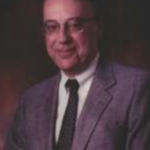The NECO alums behind the VA Optometry Service
NECO graduates played an essential role in establishing VA Optometry and building it into a medically integrated service, in large part because of the clinical training model they experienced first-hand as students.
Today, every NECO student rotates through a VA facility, and many go on to complete VA residencies or fellowships, or become VA optometrists.
The NECO training model was years ahead of its time. Co-managing patients, communicating with other medical professionals, and advocating for the role of optometrists as respected members of a healthcare team were progressive ideas in the 1970s, making alums uniquely qualified to lay the groundwork for VA Optometry and provide the advanced care needed by VA patients.
The VA Optometry Service is now a major employer of optometrists, and provides the largest U.S. clinical training program for future eye care professionals.
Laying the foundation
- 1970-1976. Charles Mullen, OD ‘69, NECO’s director of clinical development, designs a new model of clinical training, placing optometry students in settings where they are integrated with other healthcare providers. These include community health centers and the VA.
 1974. Kenneth Myers, OD ‘74, becomes the founding director of optometry for the VA. He promotes the expansion of extern and residency programs. “I was part of that model when I was a student at NECO. We had no fear about operating in medical settings, thanks to Charlie Mullen.” – Dr. Myers “I had been trained at NECO to view optometry as comparable to medicine. This new model made eminently good sense to me, and the VA was another place to implement it.”
1974. Kenneth Myers, OD ‘74, becomes the founding director of optometry for the VA. He promotes the expansion of extern and residency programs. “I was part of that model when I was a student at NECO. We had no fear about operating in medical settings, thanks to Charlie Mullen.” – Dr. Myers “I had been trained at NECO to view optometry as comparable to medicine. This new model made eminently good sense to me, and the VA was another place to implement it.”- 1976. Dr. Myers works with the American Optometric Association to win congressional approval for PL 94-581, establishing the VA Optometry Service.
- 1976-1980. Dr. Myers’ fights to get optometrists the same pay and promotion grade as other VA medical professionals. He receives approval and increases the number of staff optometrists. Many of the initial hires are NECO graduates, all of whom move on to leadership positions at the VA or the college.NECO graduates hired in the initial wave include Clifford Scott, OD ’68 (president of NECO 2009-2018), Barry Fisch, OD ’71, Rodney Gutner, OD ’73, and Gerald Selvin, OD ’73.
“The NECO alums were among a few optometrists who were trained to do the type of advanced care the VA needed,” stated Dr. Myers. “Charlie Mullen trained us in a way that was years ahead of its time, and we took the model and ran with it.”
- 1981-2008. Dr. Gutner significantly expands VA extern and residency programs. NECO students benefit from treating a diverse patient population, the VA gains additional providers, and the patients receive thorough, high-quality exams.
- 2003. Anthony Cavallerano, OD ’72, along with Dr. Fisch and Dr. Selvin, plays a pivotal role in launching the VA Boston Ocular Telehealth Center and Diabetic Teleretinal Imaging Program, to screen VA patients for diabetic retinopathy and related disorders. It becomes a national program in 2006.
- 2003. Dr. Fisch leads the VA’s bid to launch a research fellowship program in collaboration with NECO, training optometrists in clinical research. The strong didactic component of NECO’s graduate research is key to building the fellowship program.
Today’s VA Optometry Service and Training (source: va.gov/optometry)
- Over 950 VA optometrists provide the majority of primary eye care and vision rehabilitation services for U.S. veterans.
- 350 VA sites offering optometry services.
- About 70% of U.S. optometry school and college graduates have performed public health care services at VHA medical facilities.
- There are over 215 postgraduate residency positions available annually.
Article source: NECO Annual Report 2008